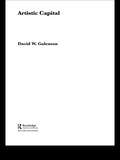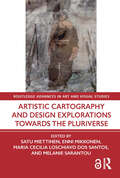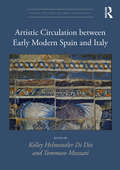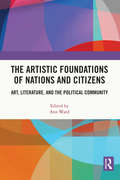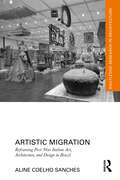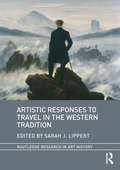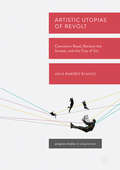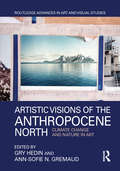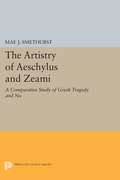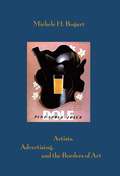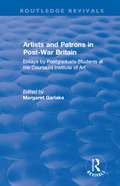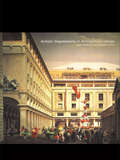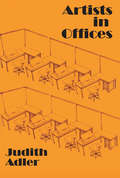- Table View
- List View
Artistic Capital
by David GalensonAt what stage of their careers do great artists produce their most important work? In a series of studies that bring new insights and new dimensions to the study of artistic creativity, Galenson’s new book examines the careers of more than one hundred modern painters, poets and novelists to reveal a powerful relationship between age and artistic creativity. Analyzing the careers of major literary and artistic figures, such as Cézanne, van Gogh, Dickens, Hemingway and Plath, Galenson highlights the different methods by which artists have made innovations. Pointing to a new and richer history of the modern arts, this book is of interest, not only to humanists and social scientists, but to anyone interested in the nature of human creativity in general.
Artistic Cartography and Design Explorations Towards the Pluriverse (Routledge Advances in Art and Visual Studies)
by Satu Miettinen Enni Mikkonen Maria Cecilia Loschiavo dos Santos Melanie SarantouThis edited volume uses an interdisciplinary approach to art and design that not only reframes but also repositions agendas and actions to address fragmented global systems. Contributors explore the pluriverse of art and design through epistemological and methodological considerations. What kinds of sustainable ways are there for knowledge transfer, supporting plural agendas, finding novel ways for unsettling conversations, unlearning and learning and challenging power structures with marginalised groups and contexts through art and design? The main themes of the book are art and design methods, epistemologies and practices that provide critical, interdisciplinary, pluriversal and decolonial considerations. The book challenges the domination of the white logic of art and design and shifts away from the Anglo-European one-world system towards the pluriverse. The book will be of interest to scholars working in art history, visual studies, arts-based research, and design studies.
Artistic Cartography and Design Explorations Towards the Pluriverse (Routledge Advances in Art and Visual Studies)
by Satu Miettinen Enni Mikkonen Maria Cecilia Loschiavo Dos Santos Melanie SarantouThis edited volume uses an interdisciplinary approach to art and design that not only reframes but also repositions agendas and actions to address fragmented global systems. Contributors explore the pluriverse of art and design through epistemological and methodological considerations. What kinds of sustainable ways are there for knowledge transfer, supporting plural agendas, finding novel ways for unsettling conversations, unlearning and learning and challenging power structures with marginalised groups and contexts through art and design? The main themes of the book are art and design methods, epistemologies and practices that provide critical, interdisciplinary, pluriversal and decolonial considerations. The book challenges the domination of the white logic of art and design and shifts away from the Anglo-European one-world system towards the pluriverse. The book will be of interest to scholars working in art history, visual studies, arts-based research, and design studies.
Artistic Circulation between Early Modern Spain and Italy (Visual Culture in Early Modernity)
by Kelley Helmstutler Di Dio Tommaso MozzatiThis collection of essays by major scholars in the field explores how the rich intersections between Italy and Spain during the early modern period resulted in a confluence of cultural ideals. Various means of exchange and convergence are explored through two main catalysts: humans—their trips or resettlements—and objects—such as books, paintings, sculptures, and prints. The visual and textual evidence of the transmission of ideas, iconographies and styles are examined, such as triumphal ephemera, treatises on painting, the social status of the artist, collections and their display, church decoration, and funerary monuments, providing a more nuanced understanding of the exchanges of styles, forms and ideals across southern Europe.
Artistic Circulation between Early Modern Spain and Italy (Visual Culture in Early Modernity)
by Kelley Helmstutler Di Dio Tommaso MozzatiThis collection of essays by major scholars in the field explores how the rich intersections between Italy and Spain during the early modern period resulted in a confluence of cultural ideals. Various means of exchange and convergence are explored through two main catalysts: humans—their trips or resettlements—and objects—such as books, paintings, sculptures, and prints. The visual and textual evidence of the transmission of ideas, iconographies and styles are examined, such as triumphal ephemera, treatises on painting, the social status of the artist, collections and their display, church decoration, and funerary monuments, providing a more nuanced understanding of the exchanges of styles, forms and ideals across southern Europe.
The Artistic Foundations of Nations and Citizens: Art, Literature, and the Political Community
by Ann WardThis book examines politics through the lens of art and literature. Through discussion on great works of visual art, literature, and cultural representations of political thought in the medieval, early modern, and American eras, it explores the relevance of the nation-state to human freedom and flourishing, as well as the concept of citizenship and statesmanship that it implies, in contrast to that of the ‘global community’. The essays in this volume focus on shifting notions of various core political concepts like citizenship, republicanism, and nationalism from antiquity to the present-day to provide a systematic understanding of their evolving histories through Western Art and literature. It highlights works such as the Bayeux Tapestry, Shakespeare’s Henry V, Henry VI, and A Midsummer Night’s Dream, Twain’s Joan of Arc and Hermann’s Nichts als Gespenster, among several other canonical works of political interest. Further, it questions if we should now look beyond the nation-state to some form of tans-national, global community to pursue the human freedom desired by progressives, or look at smaller forms of community resembling the polis to pursue the friendship and nobility valued by the ancients. The volume will be invaluable to students and teachers of political science, especially political theory and philosophy, visual arts, and world literature.
The Artistic Foundations of Nations and Citizens: Art, Literature, and the Political Community
by Ann WardThis book examines politics through the lens of art and literature. Through discussion on great works of visual art, literature, and cultural representations of political thought in the medieval, early modern, and American eras, it explores the relevance of the nation-state to human freedom and flourishing, as well as the concept of citizenship and statesmanship that it implies, in contrast to that of the ‘global community’. The essays in this volume focus on shifting notions of various core political concepts like citizenship, republicanism, and nationalism from antiquity to the present-day to provide a systematic understanding of their evolving histories through Western Art and literature. It highlights works such as the Bayeux Tapestry, Shakespeare’s Henry V, Henry VI, and A Midsummer Night’s Dream, Twain’s Joan of Arc and Hermann’s Nichts als Gespenster, among several other canonical works of political interest. Further, it questions if we should now look beyond the nation-state to some form of tans-national, global community to pursue the human freedom desired by progressives, or look at smaller forms of community resembling the polis to pursue the friendship and nobility valued by the ancients. The volume will be invaluable to students and teachers of political science, especially political theory and philosophy, visual arts, and world literature.
Artistic gymnastics (Large Print)
by RnibThis page shows images of gymnasts taking part in five events: the high bar, the pommel horse, the rings, the uneven bars, and the beam. Each image has a dashed line image border. There is a locator dot shown, which will be at the top left of the page when the image is the right way up. The high bar (top left) This athlete is shown balanced on the high bar on one hand. He is seen upside down from the front. His feet are at the top centre of the image, and down the page from this are his legs and torso with one bent arm to the right. Further down is his head and his other straight arm with his hand holding onto the bar running horizontally across the bottom of the image. He is wearing tracksuit trousers, a singlet, and gloves to protect his hands. The pommel horse (top centre) This gymnast is seen from the back, balancing upside down on a pommel horse. His legs are at the top of the image stretching out to the right and left horizontally. Down the page is his torso and head. His arms, to either side of his head, continue down to hands holding on to the handles of the pommel horse. He is wearing tracksuit trousers and a singlet. Further down the page is the pommel horse with legs extending to the floor at the bottom of the image. The rings (top right) This gymnast is performing the very demanding iron cross exercise on the rings. He is seen from the front with his head at the top of the image. At the top of the image, to the left and right, are the ring's ropes; they continue upwards out of the image border. Between these is the gymnast's head, and stretching out horizontally left and right his arms can be found with his gloved hands gripping the two rings. His torso is down the page from his head and further down you can find his legs hanging down to the bottom of the image. He is wearing tracksuit trousers and a singlet. The uneven (asymmetric) bars (bottom left) In this picture the athlete, seen from the front, is in mid-air swinging from one bar to the other. The gymnast's arms reach out to the left and right at the top of the image with her hands held up ready to catch the top bar. Between her arms, her head can be found with her hair styled into a bun. Further down the page is her torso, and down again her legs stretch out in a 'splits' position to the left and right. She is wearing a leotard. The upper bar extends across the page in front of her legs and torso, and the lower one is at the bottom of the image and closer than the top bar. The beam (bottom right) This gymnast is performing an exercise on the ten-centimetre-wide balance beam. She is seen from the side with her legs stretching left and right across the top of the image. Her torso is in the middle of the page. Down the page to the left, one of her arms is visible with her hand holding the beam and to the right her head facing to the right. She is wearing a leotard. The beam extends across the bottom of the image.
Artistic gymnastics (UEB Contracted)
by RnibThis page shows images of gymnasts taking part in five events: the high bar, the pommel horse, the rings, the uneven bars, and the beam. Each image has a dashed line image border. There is a locator dot shown, which will be at the top left of the page when the image is the right way up. The high bar (top left) This athlete is shown balanced on the high bar on one hand. He is seen upside down from the front. His feet are at the top centre of the image, and down the page from this are his legs and torso with one bent arm to the right. Further down is his head and his other straight arm with his hand holding onto the bar running horizontally across the bottom of the image. He is wearing tracksuit trousers, a singlet, and gloves to protect his hands. The pommel horse (top centre) This gymnast is seen from the back, balancing upside down on a pommel horse. His legs are at the top of the image stretching out to the right and left horizontally. Down the page is his torso and head. His arms, to either side of his head, continue down to hands holding on to the handles of the pommel horse. He is wearing tracksuit trousers and a singlet. Further down the page is the pommel horse with legs extending to the floor at the bottom of the image. The rings (top right) This gymnast is performing the very demanding iron cross exercise on the rings. He is seen from the front with his head at the top of the image. At the top of the image, to the left and right, are the ring's ropes; they continue upwards out of the image border. Between these is the gymnast's head, and stretching out horizontally left and right his arms can be found with his gloved hands gripping the two rings. His torso is down the page from his head and further down you can find his legs hanging down to the bottom of the image. He is wearing tracksuit trousers and a singlet. The uneven (asymmetric) bars (bottom left) In this picture the athlete, seen from the front, is in mid-air swinging from one bar to the other. The gymnast's arms reach out to the left and right at the top of the image with her hands held up ready to catch the top bar. Between her arms, her head can be found with her hair styled into a bun. Further down the page is her torso, and down again her legs stretch out in a 'splits' position to the left and right. She is wearing a leotard. The upper bar extends across the page in front of her legs and torso, and the lower one is at the bottom of the image and closer than the top bar. The beam (bottom right) This gymnast is performing an exercise on the ten-centimetre-wide balance beam. She is seen from the side with her legs stretching left and right across the top of the image. Her torso is in the middle of the page. Down the page to the left, one of her arms is visible with her hand holding the beam and to the right her head facing to the right. She is wearing a leotard. The beam extends across the bottom of the image.
Artistic gymnastics (UEB Uncontracted)
by RnibThis page shows images of gymnasts taking part in five events: the high bar, the pommel horse, the rings, the uneven bars, and the beam. Each image has a dashed line image border. There is a locator dot shown, which will be at the top left of the page when the image is the right way up. The high bar (top left) This athlete is shown balanced on the high bar on one hand. He is seen upside down from the front. His feet are at the top centre of the image, and down the page from this are his legs and torso with one bent arm to the right. Further down is his head and his other straight arm with his hand holding onto the bar running horizontally across the bottom of the image. He is wearing tracksuit trousers, a singlet, and gloves to protect his hands. The pommel horse (top centre) This gymnast is seen from the back, balancing upside down on a pommel horse. His legs are at the top of the image stretching out to the right and left horizontally. Down the page is his torso and head. His arms, to either side of his head, continue down to hands holding on to the handles of the pommel horse. He is wearing tracksuit trousers and a singlet. Further down the page is the pommel horse with legs extending to the floor at the bottom of the image. The rings (top right) This gymnast is performing the very demanding iron cross exercise on the rings. He is seen from the front with his head at the top of the image. At the top of the image, to the left and right, are the ring's ropes; they continue upwards out of the image border. Between these is the gymnast's head, and stretching out horizontally left and right his arms can be found with his gloved hands gripping the two rings. His torso is down the page from his head and further down you can find his legs hanging down to the bottom of the image. He is wearing tracksuit trousers and a singlet. The uneven (asymmetric) bars (bottom left) In this picture the athlete, seen from the front, is in mid-air swinging from one bar to the other. The gymnast's arms reach out to the left and right at the top of the image with her hands held up ready to catch the top bar. Between her arms, her head can be found with her hair styled into a bun. Further down the page is her torso, and down again her legs stretch out in a 'splits' position to the left and right. She is wearing a leotard. The upper bar extends across the page in front of her legs and torso, and the lower one is at the bottom of the image and closer than the top bar. The beam (bottom right) This gymnast is performing an exercise on the ten-centimetre-wide balance beam. She is seen from the side with her legs stretching left and right across the top of the image. Her torso is in the middle of the page. Down the page to the left, one of her arms is visible with her hand holding the beam and to the right her head facing to the right. She is wearing a leotard. The beam extends across the bottom of the image.
Artistic Migration: Reframing Post-War Italian Art, Architecture, and Design in Brazil (Routledge Research in Architecture)
by Aline Coelho SanchesArtistic Migration: Reframing Post-War Italian Art, Architecture, and Design in Brazil investigates a selection of works by Italian artists and architects, and an art critic and dealer, who immigrated to Brazil after World War II, and were involved in the first activities and opportunities created by the São Paulo Museum of Art (MASP).Although foreigners, these experts, namely Bramante Buffoni, Roberto Sambonet, Lina Bo Bardi, Giancarlo Palanti, and Pietro Maria Bardi, were engaged in the construction of paths for Brazilian art, architecture, and design, in production marked by the intertwining of artistic disciplines. By examining the works produced between 1946 and 1991, and focusing on the relationship between art and architecture, with previously unexplored cases, the text investigates how these actors engaged in the dilemmas of Brazilian culture and became part of its invention. The intention is to understand the nature and meaning of this recognizable experience, the continuities of and ruptures from modern architectural, art and design ideals, pre-war experience, and immigration, illuminating a complex framework of relationships with local ideas.The approach and the extensive archival research in Italy and Brazil adopted for the book sheds new light on critically rethinking and reframing Italian and Brazilian cultural events, and will be of interest to architects, researchers, teachers, and students interested in the history of architecture, museums, design, and art.
Artistic Migration: Reframing Post-War Italian Art, Architecture, and Design in Brazil (Routledge Research in Architecture)
by Aline Coelho SanchesArtistic Migration: Reframing Post-War Italian Art, Architecture, and Design in Brazil investigates a selection of works by Italian artists and architects, and an art critic and dealer, who immigrated to Brazil after World War II, and were involved in the first activities and opportunities created by the São Paulo Museum of Art (MASP).Although foreigners, these experts, namely Bramante Buffoni, Roberto Sambonet, Lina Bo Bardi, Giancarlo Palanti, and Pietro Maria Bardi, were engaged in the construction of paths for Brazilian art, architecture, and design, in production marked by the intertwining of artistic disciplines. By examining the works produced between 1946 and 1991, and focusing on the relationship between art and architecture, with previously unexplored cases, the text investigates how these actors engaged in the dilemmas of Brazilian culture and became part of its invention. The intention is to understand the nature and meaning of this recognizable experience, the continuities of and ruptures from modern architectural, art and design ideals, pre-war experience, and immigration, illuminating a complex framework of relationships with local ideas.The approach and the extensive archival research in Italy and Brazil adopted for the book sheds new light on critically rethinking and reframing Italian and Brazilian cultural events, and will be of interest to architects, researchers, teachers, and students interested in the history of architecture, museums, design, and art.
Artistic Responses to Travel in the Western Tradition (Routledge Research in Art History)
by Sarah J. LippertIn an era when ease of travel is greater than ever, it is also easy to overlook the degree to which voyages of the body – and mind – have generated an outpouring of artistry and creativity throughout the ages. Exploration of new lands and sensations is a fundamental human experience. This volume in turn provides a stimulating and adventurous exploration of the theme of travel from an art-historical perspective. Topical regions are covered ranging from the Grand Tour and colonialism to the travels of Hadrian in ancient times and Georgia O’Keeffe’s journey to the Andes; from Vasari’s Neoplatonic voyages to photographing nineteenth-century Japan. The scholars assembled consider both imaginary travel, as well as factual or embellished documentation of voyages. The essays are far-reaching spatially and temporally, but all relate to how art has documented the theme of travel in varying media across time and as illustrated and described by writers, artists, and illustrators. The scope of this volume is far-reaching both chronologically and conceptually, thereby appropriately documenting the universality of the theme to human experience.
Artistic Responses to Travel in the Western Tradition (Routledge Research in Art History)
by Sarah J. LippertIn an era when ease of travel is greater than ever, it is also easy to overlook the degree to which voyages of the body – and mind – have generated an outpouring of artistry and creativity throughout the ages. Exploration of new lands and sensations is a fundamental human experience. This volume in turn provides a stimulating and adventurous exploration of the theme of travel from an art-historical perspective. Topical regions are covered ranging from the Grand Tour and colonialism to the travels of Hadrian in ancient times and Georgia O’Keeffe’s journey to the Andes; from Vasari’s Neoplatonic voyages to photographing nineteenth-century Japan. The scholars assembled consider both imaginary travel, as well as factual or embellished documentation of voyages. The essays are far-reaching spatially and temporally, but all relate to how art has documented the theme of travel in varying media across time and as illustrated and described by writers, artists, and illustrators. The scope of this volume is far-reaching both chronologically and conceptually, thereby appropriately documenting the universality of the theme to human experience.
Artistic Utopias of Revolt: Claremont Road, Reclaim the Streets, and the City of Sol (Palgrave Studies in Utopianism)
by Julia Ramírez BlancoThis book analyses the aesthetic and utopian dimensions of various activist social movements in Western Europe since 1989. Through a series of case studies, it demonstrates how dreams of a better society have manifested themselves in contexts of political confrontation, and how artistic forms have provided a language to express the collective desire for social change.The study begins with the 1993 occupation of Claremont Road in east London, an attempt to prevent the demolition of homes to make room for a new motorway. In a squatted row of houses, all available space was transformed and filled with elements that were both aesthetic and defensive – so when the authorities arrived to evict the protestors, sculptures were turned into barricades. At the end of the decade, this kind of performative celebration merged with the practices of the antiglobalisation movement, where activists staged spectacular parallel events alongside the global elite’s international meetings. As this book shows, social movements try to erase the distance that separates reality and political desire, turning ordinary people into creators of utopias. Squatted houses, carnivalesque street parties, counter-summits, and camps in central squares, all create a physical place of these utopian visions
Artistic Utopias of Revolt: Claremont Road, Reclaim the Streets, and the City of Sol (Palgrave Studies in Utopianism)
by Julia Ramírez BlancoThis book analyses the aesthetic and utopian dimensions of various activist social movements in Western Europe since 1989. Through a series of case studies, it demonstrates how dreams of a better society have manifested themselves in contexts of political confrontation, and how artistic forms have provided a language to express the collective desire for social change.The study begins with the 1993 occupation of Claremont Road in east London, an attempt to prevent the demolition of homes to make room for a new motorway. In a squatted row of houses, all available space was transformed and filled with elements that were both aesthetic and defensive – so when the authorities arrived to evict the protestors, sculptures were turned into barricades. At the end of the decade, this kind of performative celebration merged with the practices of the antiglobalisation movement, where activists staged spectacular parallel events alongside the global elite’s international meetings. As this book shows, social movements try to erase the distance that separates reality and political desire, turning ordinary people into creators of utopias. Squatted houses, carnivalesque street parties, counter-summits, and camps in central squares, all create a physical place of these utopian visions
Artistic Visions of the Anthropocene North: Climate Change and Nature in Art (Routledge Advances in Art and Visual Studies)
by Gry Hedin Ann-Sofie N. GremaudIn the era of the Anthropocene, artists and scientists are facing a new paradigm in their attempts to represent nature. Seven chapters, which focus on art from 1780 to the present that engages with Nordic landscapes, argue that a number of artists in this period work in the intersection between art, science, and media technologies to examine the human impact on these landscapes and question the blurred boundaries between nature and the human. Canadian artists such as Lawren Harris and Geronimo Inutiq are considered alongside artists from Scandinavia and Iceland such as J.C. Dahl, Eija-Liisa Ahtila, Toril Johannessen, and Björk.
Artistic Visions of the Anthropocene North: Climate Change and Nature in Art (Routledge Advances in Art and Visual Studies)
by Gry Hedin Ann-Sofie N. GremaudIn the era of the Anthropocene, artists and scientists are facing a new paradigm in their attempts to represent nature. Seven chapters, which focus on art from 1780 to the present that engages with Nordic landscapes, argue that a number of artists in this period work in the intersection between art, science, and media technologies to examine the human impact on these landscapes and question the blurred boundaries between nature and the human. Canadian artists such as Lawren Harris and Geronimo Inutiq are considered alongside artists from Scandinavia and Iceland such as J.C. Dahl, Eija-Liisa Ahtila, Toril Johannessen, and Björk.
The Artistry of Aeschylus and Zeami: A Comparative Study of Greek Tragedy and No
by Mae J. SmethurstBy means of a cross-cultural analysis of selected examples of early Japanese and early Greek drama, Mae Smethurst enhances our appreciation of each form. While using the methods of a classicist to increase our understanding of no as literary texts, she also demonstrates that the fifteenth-century treatises of Zeami--an important playwright, actor, critic, and teacher of no--offer fresh insight into Aeschylus' use of actors, language, and various elements of stage presentation.Relatively little documentation apart from the texts of the plays is available for the Greek theater of the fifth century B.C., but Smethurst uses documentation on no, and evidence from no performances today, to suggest how presentations of the Persians could have been so successful despite the play's lack of dramatic confrontation. Aeschylean theater resembles that of Zeami in creating its powerful emotional and aesthetic effect through a coherent organization of structural elements. Both playwrights used such methods as the gradual intensification of rhythmic and musical effects, an increase in the number and complexity of the actors' movements, and a progressive focusing of attention on the main actors and on costumes, masks, and props during the course of the play.Originally published in 1989.The Princeton Legacy Library uses the latest print-on-demand technology to again make available previously out-of-print books from the distinguished backlist of Princeton University Press. These editions preserve the original texts of these important books while presenting them in durable paperback and hardcover editions. The goal of the Princeton Legacy Library is to vastly increase access to the rich scholarly heritage found in the thousands of books published by Princeton University Press since its founding in 1905.
Artists, Advertising, and the Borders of Art
by Michele H. BogartNorman Rockwell and Andy Warhol, J. C. Leyendecker and Georgia O'Keeffe, the Metropolitan Museum of Art and Pepsi-Cola, the avant garde and the Famous Artists Schools, Inc.: these are some of the unexpected pairings encountered in Artists, Advertising, and the Borders of Art. In the first interdisciplinary study of the imagery and practices of commercial artists, Michele H. Bogart explores, in unprecedented detail, the world of commercial art—its illustrators, publishers, art directors, photographers, and painters. She maps out the long, permeable border between art and commerce and expands our picture of artistic culture in the twentieth century. From the turn of the century through the 1950s, the explosive growth of popular magazines and national advertising offered artists new sources of income and new opportunities for reaching huge audiences. Bogart shows how, at the same time, this change in the marketplace also forced a rethinking of the purpose of the artistic enterprise itself. She examines how illustrators such as Howard Pyle, Charles Dana Gibson, and Norman Rockwell claimed their identities as artists within a market-oriented framework. She looks at billboard production and the growing schism between "art" posters and billboard advertisements; at the new roles of the art director; at the emergence of photography as the dominant advertising medium; and at the success of painters in producing "fine art" for advertising during the 1930s and 1940s.
Artists and Patrons in Post-war Britain
by Courtauld Institute of ArtThis title was first published in 2001. An examination of art and patronage in Britain during the post-war years. It consists of five case studies, initially written as MA theses, that closely investigate aspects of the mechanisms of patronage outside the state institutions, while indicating structural links within it. The writers have sought to elucidate the relationship between patronage, the production of art and its dissemination. Without seeking to provide an inclusive account of patronage or art production in the early post-war years, their disparate and highly selective papers set up models for the structure of patronage under specific historical conditions. They assume an understanding that works of art are embedded in their social contexts, are products of the conditions under which they were produced, and that these contexts and conditions are complex, fluid and imbricated in one another.
Artists and Patrons in Post-war Britain
by Courtauld Institute of ArtThis title was first published in 2001. An examination of art and patronage in Britain during the post-war years. It consists of five case studies, initially written as MA theses, that closely investigate aspects of the mechanisms of patronage outside the state institutions, while indicating structural links within it. The writers have sought to elucidate the relationship between patronage, the production of art and its dissemination. Without seeking to provide an inclusive account of patronage or art production in the early post-war years, their disparate and highly selective papers set up models for the structure of patronage under specific historical conditions. They assume an understanding that works of art are embedded in their social contexts, are products of the conditions under which they were produced, and that these contexts and conditions are complex, fluid and imbricated in one another.
Artists' Impressions in Architectural Design: Null
by Bob Giddings Margaret HorneArtists' Impressions in Architectural Design analyses the ways in which architects have presented their designs for clients and the public, both historically and contemporarily. It spans a period from the fifteenth to the twenty-first century.Architects have become familiar with change. The passage of time has brought with it new and revived styles of architecture, as well as innovative tools and techniques for their representation. The result is that while some methods show a view of the architect's concept for a building, others offer an almost real experience of the intended architecture. This book provides a rare and valuable study in which the exciting technological developments of today are placed in context with the rich heritage of the past. It offers an opportunity to learn how architects have chosen to represent their ideas. The authors dare to glimpse into the future and hopefully offer some reassurance for tomorrow.
Artists' Impressions in Architectural Design
by Bob Giddings Margaret HorneArtists' Impressions in Architectural Design analyses the ways in which architects have presented their designs for clients and the public, both historically and contemporarily. It spans a period from the fifteenth to the twenty-first century.Architects have become familiar with change. The passage of time has brought with it new and revived styles of architecture, as well as innovative tools and techniques for their representation. The result is that while some methods show a view of the architect's concept for a building, others offer an almost real experience of the intended architecture. This book provides a rare and valuable study in which the exciting technological developments of today are placed in context with the rich heritage of the past. It offers an opportunity to learn how architects have chosen to represent their ideas. The authors dare to glimpse into the future and hopefully offer some reassurance for tomorrow.
Artists in Offices: An Ethnography of an Academic Art Scene
by Judith E. AdlerUniversities have become important sources of patronage and professional artistic preparation. With the growing academization of art instruction, young artists are increasingly socialized in bureaucratic settings, and mature artists find themselves working as organizational employees in an academic setting. As these artists lose the social marginality and independence associated with an earlier, more individual aesthetic production, much cultural mythology about work in the arts becomes obsolete.This classic ethnography, based on fieldwork and interviews carried out at the California Institute of the Arts in the 1980s, analyzes the day-to-day life of an organization devoted to work in the arts. It charts the rise and demise of a particular academic art "scene," an occupational utopian community that recruited its members by promising them an ideal work setting.Now available in paperback, it offers insight into the worlds of art and education, and how they interact in particular settings. The nature of career experience in the arts, in particular its temporal structure, makes these occupations particularly receptive to utopian thought. The occupational utopia that served as a recruitment myth for the particular organization under scrutiny is examined for what it reveals about the otherwise unexpressed impulses of the work world.
